List of Korean War flying aces
<templatestyles src="Multiple image/styles.css" wrapper=".tmulti"></templatestyles>
Dozens of aviators were credited as flying aces in the Korean War from 1950 to 1953. The number of total flying aces, who are credited with downing five or more enemy aircraft in air-to-air combat, is disputed in the war.
The Korean War saw the first widespread use of jet engine-powered fighter aircraft for both sides of a war. Subsequently, difficulty arose in crediting the number of victories for each side, thanks in part to poor records, intentional overestimation, and the difficulty of confirming crashes in MiG Alley, where the majority of air-to-air combat took place in the war. As a result, there is a large discrepancy on both sides as to the number of victories claimed versus aircraft lost, and it is extremely difficult to determine the accuracy of many victories. The ace status of dozens of pilots still remains in question.
Aviators from four nations may have qualified as aces during the Korean War; between six and nine aces have been estimated for China and up to four in North Korea. Pilots of the Soviet Union had the most difficulty confirming victories and accurately determining which pilots achieved ace status, and between 34 and 60 pilots from that nation have been postulated as possible aces in the war. For the United Nations, the United States was the only country with pilots to attain ace status, with 40. No pilot from another UN country attained ace status, though many claimed victories. Among these, Royal Canadian Air Force pilot Ernest A. Glover claimed three victories.[1]
Controversy
The status of many claimed aces in the Korean War has been increasingly debated as more data becomes available, showing that instances of over-claiming abounded on both sides.
An example of this occurred on 20 May 1951, when the war's largest fighter battle to date took place between 28 F-86 Sabres and 30 MiG-15s. After this battle the Americans claimed three MiGs (including two for James Jabara) and the Soviets claimed four Sabres (including one for Yevgeny Pepelyaev). In fact, each side lost only one aircraft.[2]
The Americans claimed that Jabara was their first jet ace after the 20 May combat but, apart from the discrepancy on that date, he was also credited with a kill in a 12 April 1951 combat in which the Americans claimed a total of 11 MiGs shot down when the Soviets actually lost only one fighter. For their part, the Soviets claimed 15 Boeing B-29 kills on that date when the Americans only lost four in the combat itself and six written-off later.[3]
Compounding the problem, both sides were using jet engine-powered fighter aircraft on a large scale for the first time, and the high speeds of combat made visual identification of damaged and destroyed aircraft difficult. USAF pilots were credited with a kill if the gun camera showed their guns striking the enemy aircraft even if no one actually saw it go down. After the war the USAF reviewed its figures in an investigation code-named Sabre Measure Charlie and downgraded the kill ratio of the North American F-86 Sabre against the Mikoyan-Gurevich MiG-15 by half.[4] The Soviets also had lax standards for confirming kills at the beginning of the war, leading to widespread over-claiming.[5] Both sides made extensive use of gun cameras to better track effectiveness, but Soviet cameras were less effective, further contributing to over-claiming.[6]
Records from the United Nations show that 40 American pilots reached ace status. However, records from China, the Soviet Union, and North Korea conflict widely and accounts vary on how many aircraft on each side were lost and who is credited with the victories.[7] Air victory claims, which are often controversial between two sides of a war, were particularly difficult to measure in Korea thanks to the difficulty recovering crashed aircraft and confirming losses, as well as poor records for the two sides which fought the bulk of their engagements in an area known as MiG Alley.[8][9]
The number of aircraft lost during the war is in dispute among both the UN and the Soviet bloc nations.[10] UN pilots claim 840 aircraft shot down during the war, while Chinese, Soviet, and North Korean sources indicate only 600 were lost among the three nations, including non-combat losses. Conversely, the Soviet Union sources claim to have shot down 800 UN aircraft, while the US claims to have lost only 100 aircraft in combat. Overestimation of victories on both sides has been attributed to the stress and confusion of air combat situations during the war, as well as the tendency for pilots to deliberately exaggerate claims for career advancement.[8] Historians suggest that numbers in these nations were deliberately exaggerated for propaganda purposes and to appease their superiors. For example, Soviet pilots faced penalties for perceived failure or ineffectiveness, making inaccurate or false claims of victories more common.[11] Conversely, data-matching with Soviet records shows that US pilots claimed up to 400 per cent more kills in some combats than they actually achieved, and that they routinely attributed their own combat losses to landing accidents and "other causes".[12]
The Soviet bloc nations claim to have destroyed a combined total of between 1,000 and 1,600 UN aircraft in air-to-air combat, the most common number in sources being 1,106 UN aircraft total, including 651 F-86 Sabres. The most authoritative Soviet numbers indicate 1,016 UN aircraft, including 595 Sabres. Chinese sources claim an additional 330 victories, including 211 Sabres. The most common number used is a total of 271 victories for China and North Korea.[13] Other, more recent works claim 1,337 UN aircraft.[14]
During the entire course of the war, UN air forces lost about 3,000 aircraft. The United States Air Force (USAF) reported a total of 516 non-combat losses and 1,466 aircraft lost in combat missions, with 757 of them lost to enemy fire[15] Of these 139 were destroyed in air-to-air combat, 305 were unknown causes and 472 were "other losses". Of these, just 78 Sabres were listed as lost in air-to-air combat, 26 were unknown causes and 61 were "other losses".[16][13][17] The United States Navy and United States Marine Corps lost 1,248 aircraft to all causes[18] and the other UN countries lost about 300 aircraft.
Tallying claims for the many Soviet pilots who claim to have achieved ace status is extremely difficult. The system of claims awards in the Soviet Union was unclear and appears to have been highly inconsistent during the war. There is also no single list of victories for each pilot in the Soviet Union, with numbers instead drawn from after action reports and accounts from pilots and unit leaders. These complications, in addition to the intentional exaggeration of kills in order to please superiors, means that the about 50 Soviet pilots claiming ace status have a total number of victories which far exceeds the number of aircraft the UN lost in the Korean War's air battles.[7] Realizing the chronic problem with false claims, Soviet leaders began to tighten the criteria for confirming victories in 1952. As a result, far fewer Soviet pilots were made aces in the second half of the war.[19]
Similarly, data-matching shows that US aces also over-claimed. [20] For example, the US claimed that James Jabara became the world's first jet-versus-jet ace during his first tour of duty, but Soviet data shows he didn't achieve ace status until his second tour.
List of aces
China
Various sources claim that between six and nine Chinese pilots attained ace status during the course of the war.[7] A USAF report listed six Chinese pilots attained ace status during the Korean War.[21] Although all Chinese aces have received the title Combat Hero in acknowledgement of their services,[22] very little information is known of the Chinese pilots during the war due to the lack of published records.[23]
Template:Legend2
Template:Legend2
| Photo | Name | Service | Victories | Unit | Aircraft | Notes |
|---|---|---|---|---|---|---|
| Zhao Baotong | PLAAF | 7[24][21] | 3rd Fighter Aviation Division[25] | MiG-15 | First Chinese pilot to achieve ace status.[25] Also known as Chao Bao Tun.[23] | |
 |
Wang Hai | PLAAF | 4-9[21] | 3rd Fighter Aviation Division[26] | MiG-15 | Although the USAF report listed Wang's nine victories, historian Zhang Xiaoming contended that only four victories were actual kills while other five were damages.[26] Also known as Van Hai.[21] |
—
|
Li Han | PLAAF | 8[21] | 4th Fighter Aviation Division[27] | MiG-15 | First Chinese pilot credited with shooting down a U.S. aircraft.[27] |
—
|
Lu Min | PLAAF | 8[21] | 12th Fighter Aviation Division[28] | MiG-15 | Later purged due to alleged connections with Marshal Lin Biao's coup attempt against Mao Zedong.[29] |
| Fan Wanzhang* | PLAAF | 8[21] | 3rd Fighter Aviation Division[22] | MiG-15 | Also known as Fan Van Chou.[23] Killed in action on August 8, 1952.[22] | |
| Sun Shenglu* | PLAAF | 6[21] | 3rd Fighter Aviation Division[30] | MiG-15 | Killed in action on December 3, 1952 near the Ch'ongch'on River.[30] | |
 |
Liu Yudi | PLAAF | 0-6[22] | 3rd Fighter Aviation Division[31] | MiG-15 | Professor Xiaoming Zhang says Liu was credited with four victories during a single mission on November 23, 1951, but USAF records said only two F-84 were actually damaged with no aircraft lost.[32] Yudi's name is not listed in the USAF report.[21] |
| Han Decai | PLAAF | 6 | 43rd Regiment of the 15th Division | MiG-15 | Credited with 5 "kills"; 4 Planes were shot down and 2 were damaged[33] | |
| Guan-Lee Sing(施光礼) | PLAAF | 4[34] | MiG-15 | |||
 |
Ji-hui Zhang | PLAAF | 3-5 | MiG-15 |
North Korea
There is some controversy as to whether any pilots of the North Korean People's Air Force attained ace status. Various sources claim there were either zero, two or four aces from North Korea.[7] Research by the USAF in 1999 concluded two North Korean pilots may have attained the status.[21] However, historian Michael J. Varhola subsequently contended that Chinese and Soviet records indicate it is unlikely any North Korean pilots attained enough victories for ace status.[23]
Template:Legend2
Template:Legend2
| Name | Service | Victories | Unit | Aircraft | Notes |
|---|---|---|---|---|---|
| Kim Den Dek | KPAF | 8 | 1st Air Division | MiG-15 | Ace status disputed.[21] |
| Kim Di San | KPAF | 6 | 1st Air Division | MiG-15 | Ace status disputed.[21] |
Soviet Union
Various sources claim between 43 and 60 pilots from the Soviet Union attained ace status in the war.[7] Most sources claim around 50 pilots attained ace status during the Korean War, of whom many are very controversial.[13] Research by the USAF named 52 pilots who may have had legitimate claim to the title. Little is known of some of the pilots and their combined tally is incompatible with the number of aircraft the USAF claims to have lost in the war.[7] Subsequent independent sources generally agree the number of aces claimed was around 52, but 15 names differ among the lists, particularly lower-scoring pilots. The number of victories for virtually all of the ace pilots is subject to dispute. Listed are names of 67 Soviet pilots attributed as aces in various sources. Of these, the ace status of 30 are in question among historians.[35]
Template:Legend2
Template:Legend2
| Name | Rank[35] | Victories[21][36] | Unit[35] | Aircraft | Notes |
|---|---|---|---|---|---|
| Nikolai Sutyagin | Major | Template:Hs22 | 17th Fighter Air Regiment, 523rd Fighter Air Regiment | MiG-15 | The 'Ace of Aces' in the Korean War, with the highest number of kills for any pilot. Awarded Hero of the Soviet Union.[37] |
| Yevgeny Pepelyaev | Colonel | Template:Hs19 | 196th Fighter Air Regiment | MiG-15 | Awarded Hero of the Soviet Union.[38] Most Russian sources credit Pepelyaev with 19[39][40] shootdowns, thought many western sources indicate 20 to 23.[41] Of the issue, Pepelyaev claimed he was "absolutely sure" of only six of his victories, of which he had seen only two of the aircraft crash into the ground.[13] |
| Lev Shchukin | Captain | Template:Hs15+2 | 18th Guards Fighter Air Regiment | MiG-15 | [42][43] |
| Alexander Smorchkov | Lieutenant colonel | Template:Hs12-15 | 523rd Fighter Air Regiment | MiG-15 | [44] |
| Dmitry Oskin | Major | Template:Hs14 | 523rd Fighter Air Regiment | MiG-15 | Number of victories is disputed, and may be 11.[21] Russian sources credit him with 16 solo and one shared victory.[45] |
| Sergey Kramarenko | Captain | Template:Hs13-16 | 176th Guards Fighter Air Regiment | MiG-15 | Awarded Hero of the Soviet Union. Scored between an estimated 3 shootdowns in World War II. Russian sources credit him with 16 shootdowns in the Korean War.[46] He was the last living Soviet flying ace of the Korean War. |
| Mikhail Ponomaryev | Major | Template:Hs10-14 | 17th Fighter Air Regiment | MiG-15 | Number of victories is disputed, and may be 11.[21]Russian sources credit 10 shootdowns.[47] |
| Konstantin Sheberstov | Major | Template:Hs12-13 | 176th Guards Fighter Air Regiment | MiG-15 | Number of victories is disputed. In 1951, Sheberstov made a false claim on one of Yevgeny Pepelyaev's victories and was exposed, disgracing himself.[38] |
| Stepan Bakhayev | Major | Template:Hs11-12 | 523rd Fighter Air Regiment | MiG-15 | Russian sources credit him with 12 shootdowns.[48] |
| Ivan Suchkov | Captain | Template:Hs10-12 | 176th Guards Fighter Regiment | MiG-15 | Number of victories is disputed and may be 10.[21][49] |
| Grigory Okhay | Captain | Template:Hs11 | 523rd Fighter Air Regiment | MiG-15 | [50] |
| Dmitry Samoilov | Senior lieutenant | Template:Hs10-11 | 523rd Fighter Air Regiment | MiG-15 | Russian sources credit him with 11 shootdowns.[51] |
| Pyotr Milaushkin | Captain | Template:Hs10 | 176th Guards Fighter Air Regiment | MiG-15 | [52] |
| Grigory Pulov | Lieutenant colonel | Template:Hs8-10 | 17th Fighter Air Regiment | MiG-15 | Number is disputed, and may be 8.[21][53] |
| Nikolai Dokashenko | Captain | Template:Hs9 | 17th Fighter Air Regiment | MiG-15 | [54] |
| Mikhail Mikhin | Captain | Template:Hs9 | 518th Fighter Air Regiment | MiG-15 | Awarded Hero of the Soviet Union.[19] |
| Serafim Subbotin | Major | Template:Hs9 | 176th Guards Fighter Air Regiment | MiG-15 | Awarded Hero of the Soviet Union. Some sources claim Subbotin had up to 15 victories, though most sources indicate a tally of 9[38] or ten.[55] |
| Vladimir Zabelin | Major | Template:Hs9 | 256th Fighter Air Regiment and 821st Fighter Air Regiment | MiG-15 | [56] |
| Grigory Ges | Captain | Template:Hs8 | 176th Guards Fighter Air Regiment | MiG-15 | Some sources claim Ges may have had up to 10 victories, though most sources agree on 8.[57][58] |
| Vladimir Alfeev | Captain | Template:Hs7 | 196th Fighter Air Regiment | MiG-15 | Listed by independent sources.[59] |
| Pavel Antonov | Major | Template:Hs7 | 18th Guards Fighter Air Regiment | MiG-15 | Listed by independent sources but not the USAF report.[59] |
| Nikolai Babonin | unknown | Template:Hs7 | 18th Guards Fighter Air Regiment | MiG-15 | Listed by the USAF report but not independent sources.[21] |
| Semyon Fedorets | Major | Template:Hs7 | 913th Fighter Air Regiment | MiG-15 | [60] |
| Lev Ivanov | Captain | Template:Hs7 | 196th Fighter Air Regiment | MiG-15 | |
| Aleksandr Karasyov | Lieutenant colonel | Template:Hs7 | 523rd Fighter Air Regiment | MiG-15 | Listed by independent sources but not the USAF report.[35][61] |
| Aleksey Mitusov | Lieutenant colonel | Template:Hs7 | 196th Fighter Air Regiment | MiG-15 | Listed by independent sources but not the USAF report.[59] |
| Vasily Shulev | Captain | Template:Hs7 | 17th Fighter Air Regiment | MiG-15 | Listed by independent sources but not the USAF report.[59] |
| Nikolai Volkov | Captain | Template:Hs7 | 17th Fighter Air Regiment | MiG-15 | Listed by independent sources but not the USAF report.[59][62] |
| Ivan Zaplavnev | Captain | Template:Hs7 | 196th Fighter Air Regiment | MiG-15 | |
| Stepan Artemchenko | Major | Template:Hs6 | 17th Fighter Air Regiment | MiG-15 | Listed by independent sources but not the USAF report.[59] Also claimed 6 kills in World War II.[63] |
| Arkady Boitsov | Major | Template:Hs6 | 16th Fighter Air Regiment | MiG-15 | Awarded Hero of the Soviet Union.[19][64] |
| Boris Bokach | Captain | Template:Hs6 | 196th Fighter Air Regiment | MiG-15 | |
| Vladimir Khvostontsev | unknown | Template:Hs6 | unknown | MiG-15 | Listed by the USAF report as an ace.[21] Other sources credit him with three kills. |
| Nikolai Ivanov | unknown | Template:Hs6 | 726th Fighter Air Regiment | MiG-15 | Listed by the USAF report but not independent sources.[21] |
| Aleksey Kalyuzhny | Major | Template:Hs6 | Fighter Air Regiment | MiG-15 | Listed by independent sources but not the USAF report.[59] |
| Anatoly Nikolayev | unknown | Template:Hs6 | 17th Fighter Air Regiment | MiG-15 | Listed by the USAF report but not independent sources.[21] |
| Pavel Nikulin | unknown | Template:Hs6 | 176th Guards Fighter Air Regiment | MiG-15 | Listed by the USAF report as an ace.[21] Other sources credit him with one kill. |
| Fyodor Shebanov* | Senior lieutenant | Template:Hs6 | 196th Fighter Air Regiment | MiG-15 | Killed in action 29 October 1951.[65][66] |
| Sergey Vishnyakov | Colonel | Template:Hs6 | 176th Guards Fighter Air Regiment | MiG-15 | [67] |
| Nikolai Zameskin | Major | Template:Hs6 | 878th Fighter Air Regiment | MiG-15 | |
| Boris Abakumov | Captain | Template:Hs5 | 196th Fighter Air Regiment | MiG-15 | |
| Anatoly Bashman | Major | Template:Hs5 | 148th Guards Fighter Air Regiment | MiG-15 | [68] |
| Vasily Belousov | unknown | Template:Hs5 | 324th Fighter Air Division (IAD), 303rd Fighter Air Division (IAD) | MiG-15 | Listed by the USAF report but not independent sources.[21] |
| Grigory Berelidze | Captain | Template:Hs5 | 224th Fighter Air Regiment | MiG-15 | |
| Georgy Bogdanov | unknown | Template:Hs5 | unknown | MiG-15 | Listed by the USAF report but not independent sources.[21] |
| Sergey Bychkov | Captain | Template:Hs5 | 17th Fighter Air Regiment | MiG-15 | Listed by the USAF report but not the US Air Force.[59] |
| Nikolai Gerasimenko | unknown | Template:Hs5 | 18th Guards Fighter Air Regiment | MiG-15 | Listed by the USAF report but not independent sources.[21] |
| Sergey Danilov | unknown | Template:Hs5 | unknown | MiG-15 | Listed by the USAF report but not independent sources.[21] |
| Grigory Dmitryuk | Major | Template:Hs5-6 | 821st Fighter Air Regiment | MiG-15 | Russian sources credit him with six kills.[69] |
| Nikolai Goncharov | Captain | Template:Hs5 | 196th Fighter Air Regiment | MiG-15 | Listed by independent sources but not the USAF report.[59][70] |
| Anatoly Karelin | Major | Template:Hs5 | 351st Fighter Air Regiment, 303rd Fighter Air Division (IAD) | MiG-15 | Awarded Hero of the Soviet Union.[19] |
| Viktor Kolyadin | Lieutenant colonel | Template:Hs5 | 28th Guards Fighter Air Regiment | MiG-15 | Listed by independent sources but not the USAF report.[35][71] |
| Nikolai Korniyenko | Captain | Template:Hs5 | 18th Guards Fighter Air Regiment | MiG-15 | |
| Aleksandr Kochegarov | unknown | Template:Hs5 | 196th Fighter Air Regiment | MiG-15 | Listed by the USAF report but not independent sources.[21] |
| Vasily Lepikov | unknown | Template:Hs5 | 415th Fighter Air Regiment | MiG-15 | Listed by the USAF report but not independent sources.[21] |
| Viktor Muravyov | Captain | Template:Hs5 | 196th Fighter Air Regiment | MiG-15 | Listed by independent sources but not the USAF report.[59] |
| Stepan Naumenko | Captain | Template:Hs5 | 29th Guards Fighter Air Regiment | MiG-15 | First Soviet ace in the war, scoring his fifth kill on 24 December 1950.[35][72] |
| Boris Obraztsov* | unknown | Template:Hs4-5 | 176th Guards Fighter Air Regiment | MiG-15 | Killed in action. Listed by the USAF report as ace, but Russian sources credit him with only four shootdowns. |
| Afanasy Olenitsa | Major | Template:Hs5 | 821st Fighter Air Regiment | MiG-15 | [73] |
| Viktor Popov | Captain | Template:Hs5 | 523rd Fighter Air Regiment | MiG-15 | Listed by independent sources but not the USAF report.[59][74] |
| Aleksey Prudnikov | unknown | Template:Hs5 | 821st Fighter Air Regiment | MiG-15 | Listed by the USAF report but not independent sources.[21] |
| German Shatalov* | Senior lieutenant | Template:Hs5 | 523rd Fighter Air Regiment | MiG-15 | Killed in action 28 November 1951. Listed by independent sources but not the USAF report.[35][75] |
| Boris Siskov | Captain | Template:Hs5 | 224th Fighter Air Regiment | MiG-15 | Final soviet ace of the war, scoring his fifth victory on July 20, 1953.[59] |
| Nikolai Shelamanov | Captain | Template:Hs5 | 196th Fighter Air Regiment | MiG-15 | |
| Vasily Stepanov | Senior lieutenant | Template:Hs5 | 18th Guards Fighter Air Regiment | MiG-15 | Listed by independent sources but not the USAF report.[59] |
| Nikolai Shkodin | unknown | Template:Hs5 | 147th Guards Fighter Air Regiment | MiG-15 | The USAF report found Shkodin had been credited with 5 victories but could only confirm three of them. Independent sources do not list Shkodin on lists of aces.[21] |
| Yevgeny Pomaz | Captain | Template:Hs2-11 | 494th Fighter Air Regiment | MiG-15 | Listed by the USAF report but not considered ace by Russian sources, which indicate only 2 shootdowns.[21][76] |
United States
Of 40 United States military servicemen who attained ace status in Korea, all but one of them flew primarily the F-86 Sabre during their air-to-air fights. Early in the war against the older North Korean People's Air Force aircraft, US pilots flew a variety of aircraft including the F-51 Mustang, F-80 Shooting Star and F-82 Twin Mustang. However, with the introduction of the MiG-15 when the People's Liberation Army Air Force entered the war, only the Sabre fighter could match the Soviet-built fighters in single combat.[77]
Similarly to the Chinese and Soviet aces, the kill totals of many American pilots are disputed. Their combined tally is incompatible with recorded losses by communist forces, and data-matching with Soviet records shows that many of the aces' claimed kills were erroneous. In some cases, American pilots over-claimed by 400 per cent after air combat.[78]
The pilots who attained ace status in the war scored a disproportionate number of kills in the war. Of 1,000 fighter pilots who served in the war, only 355 were credited with aerial victories. A total of 756.5 victories were credited for aircraft shot down by the UN, with the 40 aces shooting down a total of 310.5 aircraft, or 40 percent of the total. The top five aces are credited with a combined ten percent of the UN aircraft victories of the war.[79] In addition to the 40 pilots who attained ace status in the Korean War, another 17 US pilots who had been aces in World War II claimed additional kills in the Korean War. Two Canadian World War II aces, J. Lindsay and John McKay, also garnered additional kills in the war.[21]
| Photo | Name[1] | Service | Rank | Victories[80] | Unit | Aircraft | Notes |
|---|---|---|---|---|---|---|---|
| Template:Sortname | USAF | Captain | Template:Hs16 | 39th Fighter-Interceptor Squadron | F-86 Sabre | Was a navigator for the B-24 Liberator during World War II. Killed in a 1954 training accident.[80] | |

|
Template:Sortname | USAF | Major | Template:Hs15 | 334th Fighter-Interceptor Squadron | F-86 Sabre | America's first jet ace. Also claimed 1.5 kills (1 shared) flying a P-51 Mustang in World War II.[1] |

|
Manuel J. "Pete" Fernandez | USAF | Captain | Template:Hs14.5 (1 Shared) | 334th Fighter-Interceptor Squadron | F-86 Sabre | Killed in a 1980 aircraft crash.[1][81] |

|
George A. Davis* | USAF | Major | Template:Hs14 | 334th Fighter-Interceptor Squadron | F-86 Sabre | Shot down 10 February 1952. His death generated controversy between China and the Soviet Union, in which both MiG pilots Zhang Jihui and Mikhail Averin had claimed to be his assailant.[81] Received the Medal of Honor for his actions and posthumously promoted to the rank of lieutenant colonel. Also claimed 7 kills in the P-47 Thunderbolt in World War II.[1] |
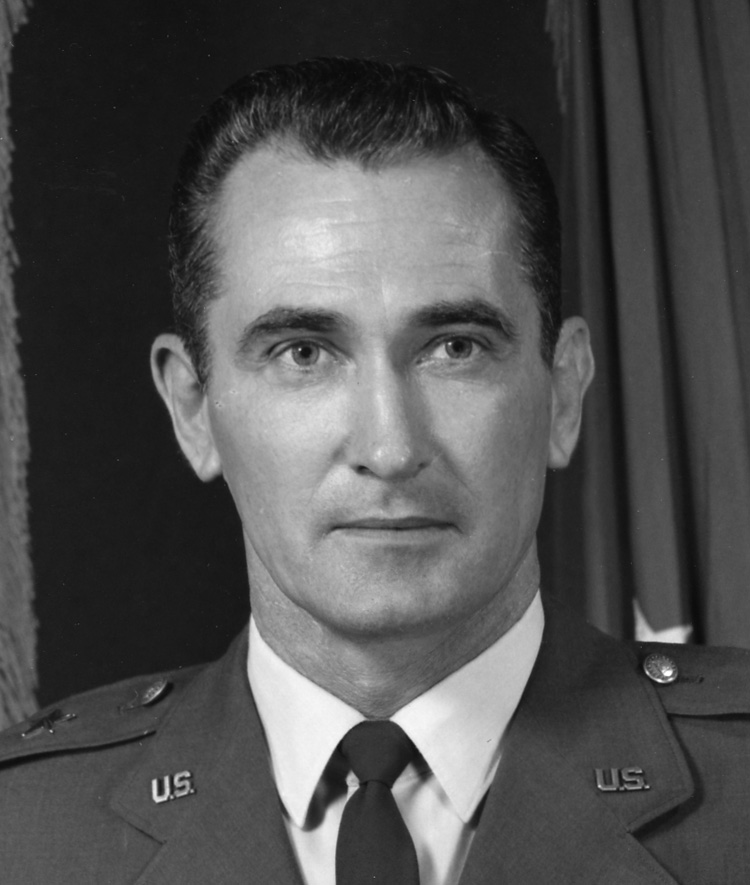
|
Royal N. "King" Baker | USAF | Colonel | Template:Hs13 | 48th Fighter Group | F-86 Sabre | Also claimed 3.5 kills (1 shared) in World War II.[1] |

|
Frederick C. "Boots" Blesse | USAF | Major | Template:Hs10 | 334th Fighter-Interceptor Squadron | P-51 Mustang F-80 Shooting Star F-86 Sabre |
"No Guts, No Glory" |
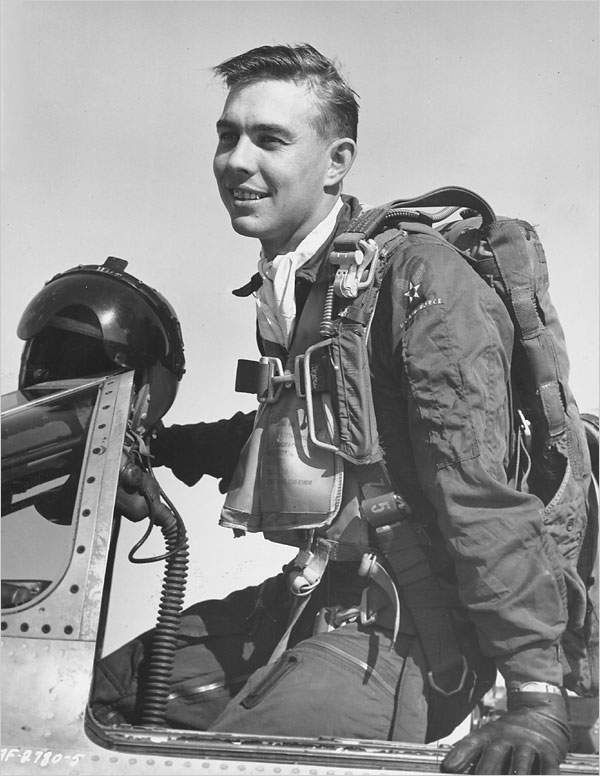
|
Harold E. Fischer | USAF | First Lieutenant | Template:Hs10 | 39th Fighter-Interceptor Squadron | F-86 Sabre | Shot down and captured in China on April 7, 1953.[82] |

|
James K. Johnson | USAF | Colonel | Template:Hs10 | 335th Fighter-Interceptor Squadron | F-86 Sabre | Also claimed 1 kill in World War II.[1] |

|
Lonnie R. Moore | USAF | Captain | Template:Hs10 | 335th Fighter-Interceptor Squadron | F-86 Sabre | Killed in a 1956 aircraft crash.[1][80] |

|
Ralph Parr | USAF | Captain | Template:Hs10 | 335th Fighter-Interceptor Squadron | F-86 Sabre | [1] |
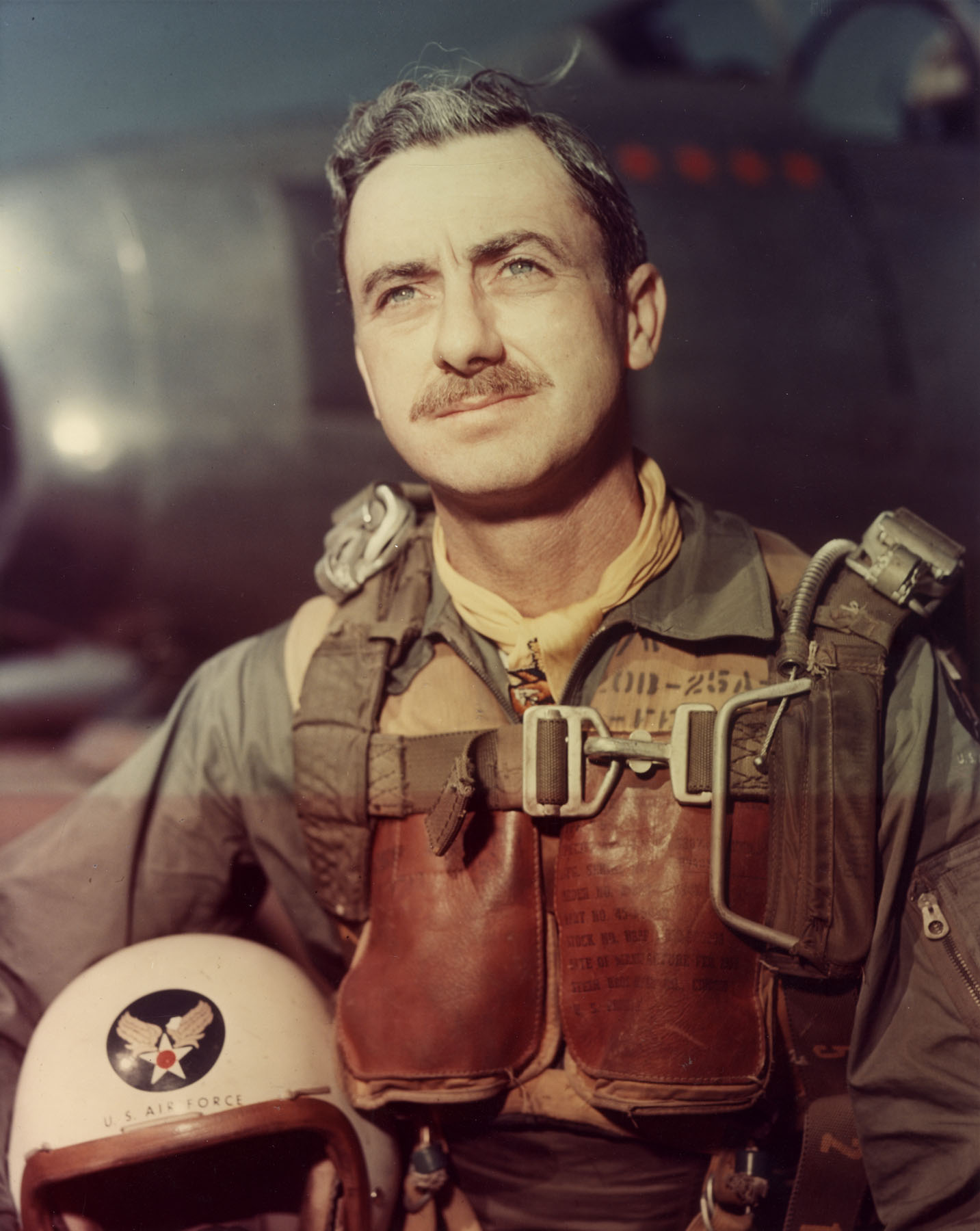
|
Vermont Garrison | USAF | Lieutenant Colonel | Template:Hs10 | 335th Fighter-Interceptor Squadron | F-86 Sabre | Also claimed 7.3 kills (1 Shared among three pilots) in World War II[1] |
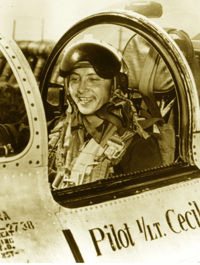
|
Cecil G. Foster | USAF | Captain | Template:Hs9 | 16th Fighter-Interceptor Squadron | F-86 Sabre | |

|
James F. Low | USAF | First Lieutenant | Template:Hs9 | 335th Fighter-Interceptor Squadron | F-86 Sabre | |

|
James P. Hagerstrom | USAF | Major | Template:Hs8.5 (1 Shared) | 334th Fighter-Interceptor Squadron, 67th Fighter-Bomber Squadron |
F-86 Sabre | Also claimed 6 kills in World War II.[1] |
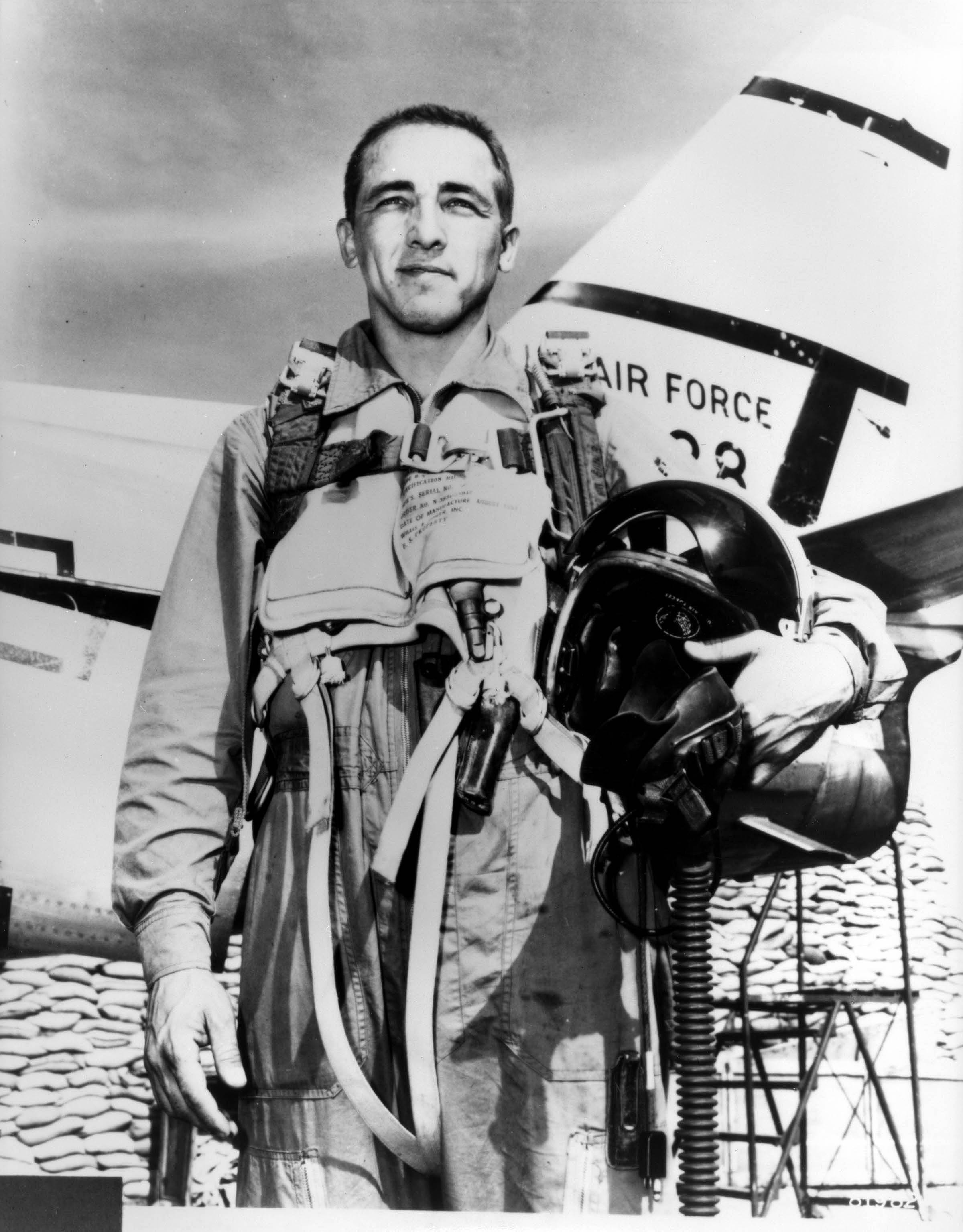
|
James Robinson "Robbie" Risner | USAF | Major | Template:Hs8 | 336th Fighter-Interceptor Squadron | F-86 Sabre | |
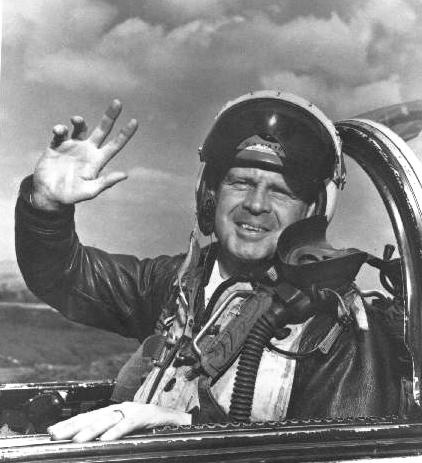
|
George I. Ruddell | USAF | Lieutenant Colonel | Template:Hs8 | 39th Fighter-Interceptor Squadron | F-86 Sabre | |

|
Henry Buttelmann | USAF | First Lieutenant | Template:Hs7 | 25th Fighter-Interceptor Squadron | F-86 Sabre | Was the youngest American ace of the war, claiming 5 victories in 12 days.[1] |

|
Clifford D. Jolley | USAF | Captain | Template:Hs7 | 335th Fighter-Interceptor Squadron | F-86 Sabre | |
—
|
Leonard W. Lilley | USAF | Captain | Template:Hs7 | 334th Fighter-Interceptor Squadron | F-86 Sabre | |

|
Donald E. Adams* | USAF | Major | Template:Hs6.5 (1 Shared) | 16th Fighter-Interceptor Squadron | F-86 Sabre | Killed in an airshow crash on August 30, 1952.[83] |
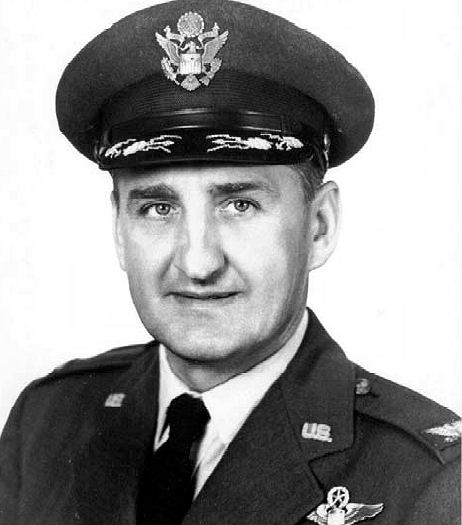
|
Francis S. "Gabby" Gabreski | USAF | Colonel | Template:Hs6.5 (1 Shared) | 4th Fighter-Interceptor Wing, 51st Fighter-Interceptor Wing |
F-86 Sabre | Also claimed 28 kills in World War II.[1] |

|
George L. Jones | USAF | Lieutenant Colonel | Template:Hs6.5 (1 Shared) | 335th Fighter-Interceptor Squadron, 51st Fighter-Interceptor Wing |
F-86 Sabre | |

|
Winton W. Marshall | USAF | Major | Template:Hs6.5 (1 Shared) | 335th Fighter-Interceptor Squadron | F-86 Sabre | |

|
John F. Bolt | USMC | Major | Template:Hs6 | 39th Fighter-Interceptor Squadron | F-86 Sabre | Also claimed 6 kills in World War II.[1] |

|
James H. Kasler | USAF | First Lieutenant | Template:Hs6 | 335th Fighter-Interceptor Squadron | F-86 Sabre | |

|
Robert J. Love | USAF | Captain | Template:Hs6 | 335th Fighter-Interceptor Squadron | F-86 Sabre | |
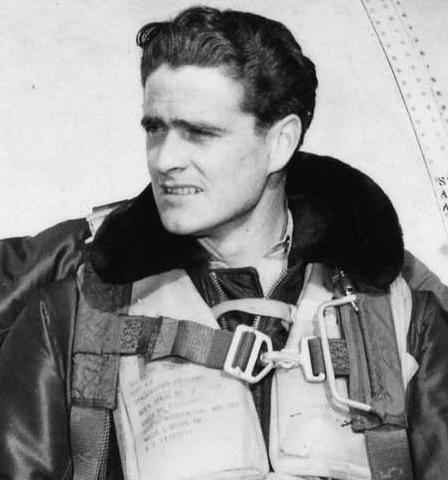
|
William T. Whisner | USAF | Major | Template:Hs5.5 (1 Shared) | 334th Fighter-Interceptor Squadron, 25th Fighter-Interceptor Squadron |
F-86 Sabre | Also claimed 16.4 kills in World War II |

|
Robert P. Baldwin | USAF | Colonel | Template:Hs5 | 16th Fighter-Interceptor Squadron, 25th Fighter-Interceptor Squadron, 39th Fighter-Interceptor Squadron |
F-86 Sabre | |
—
|
Richard S. Becker | USAF | Captain | Template:Hs5 | 334th Fighter-Interceptor Squadron | F-86 Sabre | |

|
Stephen L. Bettinger | USAF | Major | Template:Hs5 | 336th Fighter-Interceptor Squadron | F-86 Sabre | Also claimed 1 kill in World War II.[1] Was the final American ace of the war with his final victory claimed on July 20, 1953. Was subsequently shot down and taken prisoner.[84] |
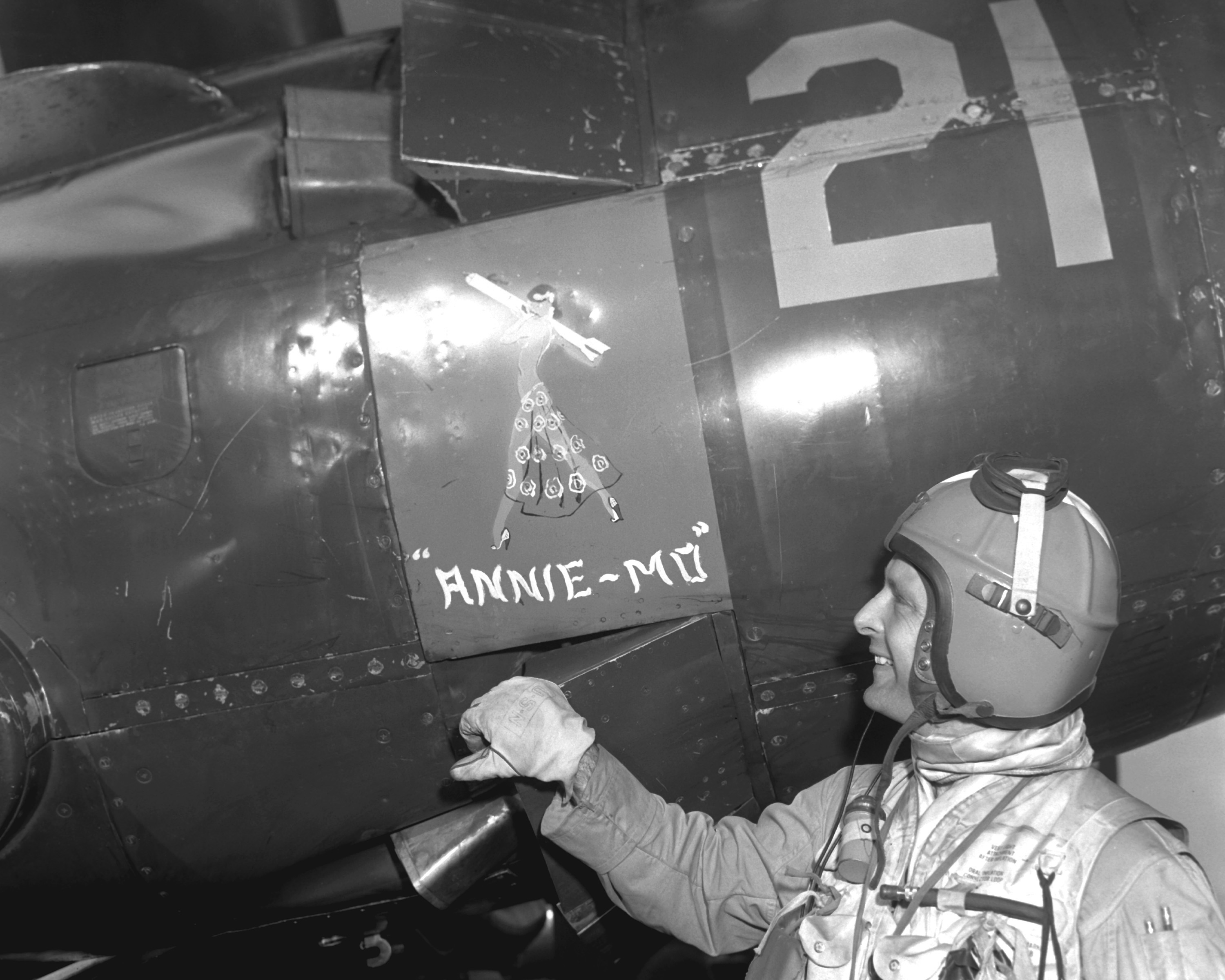
|
Guy Bordelon | USN | Lieutenant (navy) | Template:Hs5 | Composite Squadron 3 | F4U-5NL Corsair | Only US Navy aviator to be awarded ace status.[84] |
—
|
Richard D. Creighton | USAF | Major | Template:Hs5 | 336th Fighter-Interceptor Squadron | F-86 Sabre | |

|
Clyde A. Curtin | USAF | Captain | Template:Hs5 | 335th Fighter-Interceptor Squadron | F-86 Sabre | |
—
|
Ralph D. "Hoot" Gibson | USAF | Colonel | Template:Hs5 | 335th Fighter-Interceptor Squadron | F-86 Sabre] | |

|
Iven C. Kincheloe | USAF | Captain | Template:Hs5 | 25th Fighter-Interceptor Squadron | F-86 Sabre | Killed in a 1958 aircraft crash.[85] |

|
Robert T. Latshaw | USAF | Captain | Template:Hs5 | 335th Fighter-Interceptor Squadron | F-86 Sabre | |
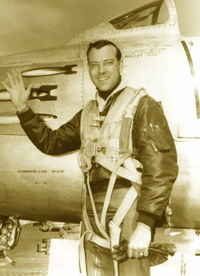
|
Robert H. Moore | USAF | Captain | Template:Hs5 | 336th Fighter-Interceptor Squadron, 16th Fighter-Interceptor Squadron |
F-86 Sabre | |

|
Dolphin D. Overton | USAF | Captain | Template:Hs5 | 16th Fighter-Interceptor Squadron | F-86 Sabre | Attained Ace status in the shortest time of any American pilot in the war with five victories in four days.[84] |

|
Harrison R. Thyng | USAF | Colonel | Template:Hs5 | 335th Fighter-Interceptor Squadron, 4th Fighter-Interceptor Wing |
F-86 Sabre | Also claimed 5 kills in World War II. Credited to have shot down pilots of more nationalities of any American ace, with victories against Nazi Germany, Vichy France and the Empire of Japan.[84] |

|
William Westcott | USAF | Major | Template:Hs5 | 25th Fighter-Interceptor Squadron, 51st Fighter-Interceptor Wing |
F-86 Sabre | |

|
Charles G. Cleveland | USAF | First Lieutenant | Template:Hs5 | 334th Fighter-Interceptor Squadron | F-86 Sabre | Fifth victory was not recognized by the US Air Force until 2008.[86] He was the last living American flying ace of the Korean War. |
References
Footnotes
Citations
Sources
<templatestyles src="Refbegin/styles.css" />
- Lua error: bad argument #1 to "get" (not a valid title).
- Lua error: bad argument #1 to "get" (not a valid title).
- Lua error: bad argument #1 to "get" (not a valid title).
- Lua error: bad argument #1 to "get" (not a valid title).
- Lua error: bad argument #1 to "get" (not a valid title).
- Lua error: bad argument #1 to "get" (not a valid title).
- Lua error: bad argument #1 to "get" (not a valid title).
- Lua error: bad argument #1 to "get" (not a valid title).
- Lua error: bad argument #1 to "get" (not a valid title).
- Lua error: bad argument #1 to "get" (not a valid title).
- Lua error: bad argument #1 to "get" (not a valid title).
- Lua error: bad argument #1 to "get" (not a valid title).
Template:Lists of flying aces Template:Korean War
- ↑ 1.00 1.01 1.02 1.03 1.04 1.05 1.06 1.07 1.08 1.09 1.10 1.11 1.12 1.13 1.14 Varhola 2000, p. 42
- ↑ Welcome to the Air Combat Information Group. Retrieved from link
- ↑ Welcome to the Air Combat Information Group. Retrieved from link
- ↑ Brune 1996, p. 215
- ↑ Krylov & Tepsurkaev 2008, p. 7
- ↑ Krylov & Tepsurkaev 2008, p. 8
- ↑ 7.0 7.1 7.2 7.3 7.4 7.5 Werrell 2005, p. 214
- ↑ 8.0 8.1 Werrell 2005, p. 141
- ↑ Krylov & Tepsurkaev 2008, p. 6
- ↑ Krylov & Tepsurkaev 2008, p. 9
- ↑ Werrell 2005, p. 142
- ↑ Welcome to the Air Combat Information Group. Retrieved from link
- ↑ 13.0 13.1 13.2 13.3 Werrell 2005, p. 143
- ↑ Werrell 2005, p. 213
- ↑ USAF Losses in Korea. Retrieved from link
- ↑ USAF Losses in Korea. Retrieved from link
- ↑ Werrell 2005, p. 143
- ↑ Hallion 1986, p. 286
- ↑ 19.0 19.1 19.2 19.3 Krylov & Tepsurkaev 2008, p. 86
- ↑ Welcome to the Air Combat Information Group. Retrieved from link
- ↑ 21.00 21.01 21.02 21.03 21.04 21.05 21.06 21.07 21.08 21.09 21.10 21.11 21.12 21.13 21.14 21.15 21.16 21.17 21.18 21.19 21.20 21.21 21.22 21.23 21.24 21.25 21.26 21.27 21.28 21.29 21.30 21.31 Lua error: bad argument #1 to "get" (not a valid title).
- ↑ 22.0 22.1 22.2 22.3 Lua error: bad argument #1 to "get" (not a valid title).
- ↑ 23.0 23.1 23.2 23.3 Varhola 2000, p. 44
- ↑ 国产新型战机列装"英雄中队"!直击歼-16战机发射PL导弹 看空军装备更新换代!「国防故事」. (30 October 2022) Retrieved 30 October 2022 from YouTube
- ↑ 25.0 25.1 Zhang 2004, p. 149.
- ↑ 26.0 26.1 Zhang 2004, p. 152.
- ↑ 27.0 27.1 Zhang 2004, p. 105.
- ↑ Zhang 2004, p. 193.
- ↑ Lua error: bad argument #1 to "get" (not a valid title).
- ↑ 30.0 30.1 Lua error: bad argument #1 to "get" (not a valid title).
- ↑ Zhang 2004, p. 153.
- ↑ Zhang 2004, p. 155.
- ↑ Confirmation of Han Decai Claims (see also December 2001 Issue of "Military History" Magazine .pp.38-44 Bergin, Bob "Chinese MiG Ace over Korea"
- ↑ [老兵你好]"空中枭雄"施光礼飞越三八线击落美P-51敌机. Retrieved 2023-10-26 from tv.cctv.com
- ↑ 35.0 35.1 35.2 35.3 35.4 35.5 35.6 Krylov & Tepsurkaev 2008, p. 88
- ↑ Seidov 2016, p. 486-489.
- ↑ Seidov 2016, p. 221.
- ↑ 38.0 38.1 38.2 Werrell 2005, p. 216
- ↑ Seidov 2016, p. 124.
- ↑ Bykov 2014, p. 920.
- ↑ Lua error: bad argument #1 to "get" (not a valid title).
- ↑ Seidov 2016, p. 190.
- ↑ Bykov 2014, p. 1375-1376.
- ↑ Seidov 2016, p. 211.
- ↑ Seidov 2016, p. 331.
- ↑ Seidov 2016, p. 99.
- ↑ Seidov 2016, p. 268.
- ↑ Seidov 2016, p. 290.
- ↑ Seidov 2016, p. 92.
- ↑ Seidov 2016, p. 224.
- ↑ Seidov 2016, p. 307.
- ↑ Seidov 2016, p. 84.
- ↑ Seidov 2016, p. 279.
- ↑ Seidov 2016, p. 251.
- ↑ Seidov 2010, p. 59.
- ↑ Seidov 2016, p. 360.
- ↑ Werrell 2005, p. 218
- ↑ Seidov 2016, p. 70.
- ↑ 59.00 59.01 59.02 59.03 59.04 59.05 59.06 59.07 59.08 59.09 59.10 59.11 59.12 Krylov & Tepsurkaev 2008, p. 89
- ↑ Seidov 2010, p. 438.
- ↑ Seidov 2016, p. 327.
- ↑ Seidov 2016, p. 259.
- ↑ Seidov 2010, p. 235.
- ↑ Seidov 2010, p. 349.
- ↑ Krylov & Tepsurkaev 2008, p. 93.
- ↑ Seidov 2016, p. 50.
- ↑ Seidov 2016, p. 96.
- ↑ Seidov 2016, p. 356.
- ↑ Seidov 2016, p. 372.
- ↑ Seidov 2016, p. 75.
- ↑ Seidov 2016, p. 31.
- ↑ Seidov 2016, p. 23.
- ↑ Seidov 2016, p. 375.
- ↑ Seidov 2016, p. 303.
- ↑ Seidov 2016, p. 299.
- ↑ Bykov 2014, p. 959.
- ↑ Lua error: bad argument #1 to "get" (not a valid title).
- ↑ Welcome to the Air Combat Information Group. Retrieved from link
- ↑ Werrell 2005, p. 184
- ↑ 80.0 80.1 80.2 Gurney 1958, p. 248
- ↑ 81.0 81.1 Werrell 2005, p. 185
- ↑ Dorr & Lake 1999, p. 77
- ↑ Dorr & Lake 1999, p. 42
- ↑ 84.0 84.1 84.2 84.3 Varhola 2000, p. 43
- ↑ Dorr & Lake 1999, p. 96
- ↑ Lua error: bad argument #1 to "get" (not a valid title).


